light CADILLAC ESCALADE 2010 3.G User Guide
[x] Cancel search | Manufacturer: CADILLAC, Model Year: 2010, Model line: ESCALADE, Model: CADILLAC ESCALADE 2010 3.GPages: 616, PDF Size: 39.41 MB
Page 46 of 616
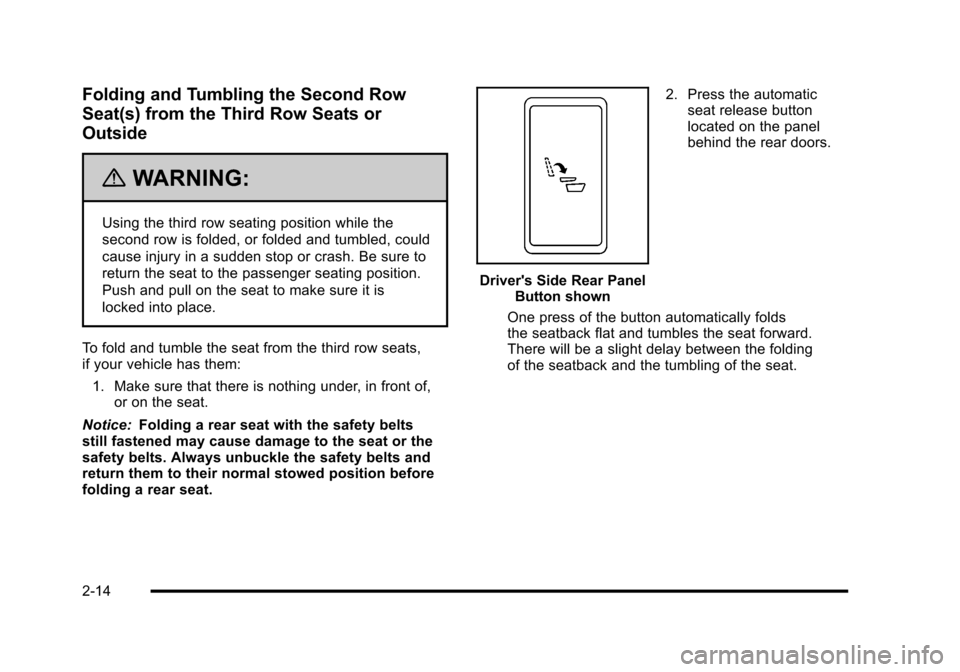
Folding and Tumbling the Second Row
Seat(s) from the Third Row Seats or
Outside
{WARNING:
Using the third row seating position while the
second row is folded, or folded and tumbled, could
cause injury in a sudden stop or crash. Be sure to
return the seat to the passenger seating position.
Push and pull on the seat to make sure it is
locked into place.
To fold and tumble the seat from the third row seats,if your vehicle has them:
1. Make sure that there is nothing under, in front of,or on the seat.
Notice:Folding a rear seat with the safety beltsstill fastened may cause damage to the seat or thesafety belts. Always unbuckle the safety belts andreturn them to their normal stowed position beforefolding a rear seat.
Driver's Side Rear PanelButton shown
2. Press the automaticseat release buttonlocated on the panelbehind the rear doors.
One press of the button automatically foldsthe seatback flat and tumbles the seat forward.There will be a slight delay between the foldingof the seatback and the tumbling of the seat.
2-14
Page 53 of 616
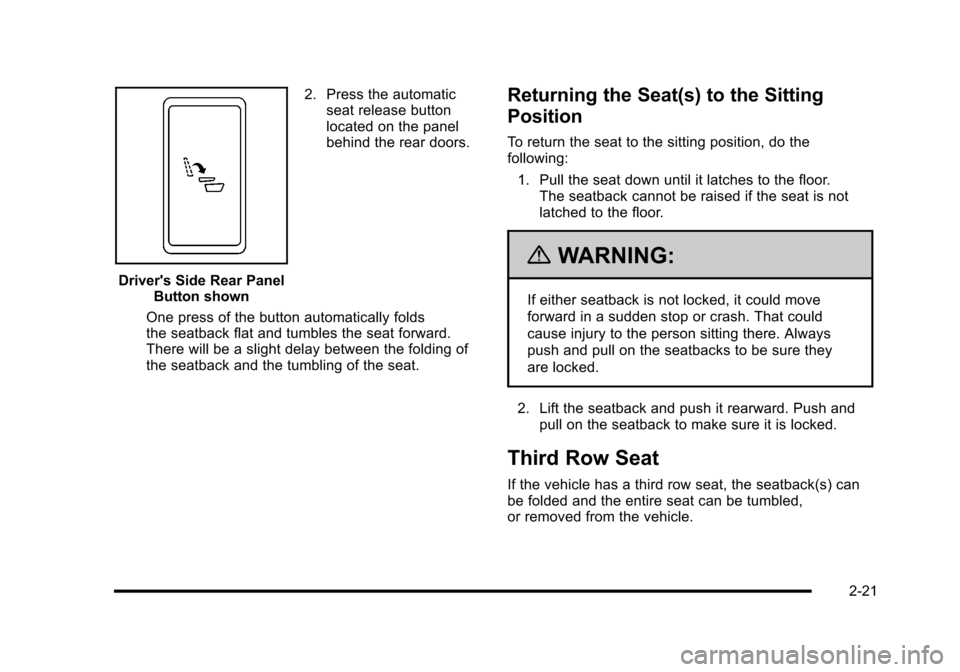
Driver's Side Rear PanelButton shown
2. Press the automaticseat release buttonlocated on the panelbehind the rear doors.
One press of the button automatically foldsthe seatback flat and tumbles the seat forward.There will be a slight delay between the folding ofthe seatback and the tumbling of the seat.
Returning the Seat(s) to the Sitting
Position
To return the seat to the sitting position, do thefollowing:
1. Pull the seat down until it latches to the floor.The seatback cannot be raised if the seat is notlatched to the floor.
{WARNING:
If either seatback is not locked, it could move
forward in a sudden stop or crash. That could
cause injury to the person sitting there. Always
push and pull on the seatbacks to be sure they
are locked.
2. Lift the seatback and push it rearward. Push andpull on the seatback to make sure it is locked.
Third Row Seat
If the vehicle has a third row seat, the seatback(s) canbe folded and the entire seat can be tumbled,or removed from the vehicle.
2-21
Page 57 of 616
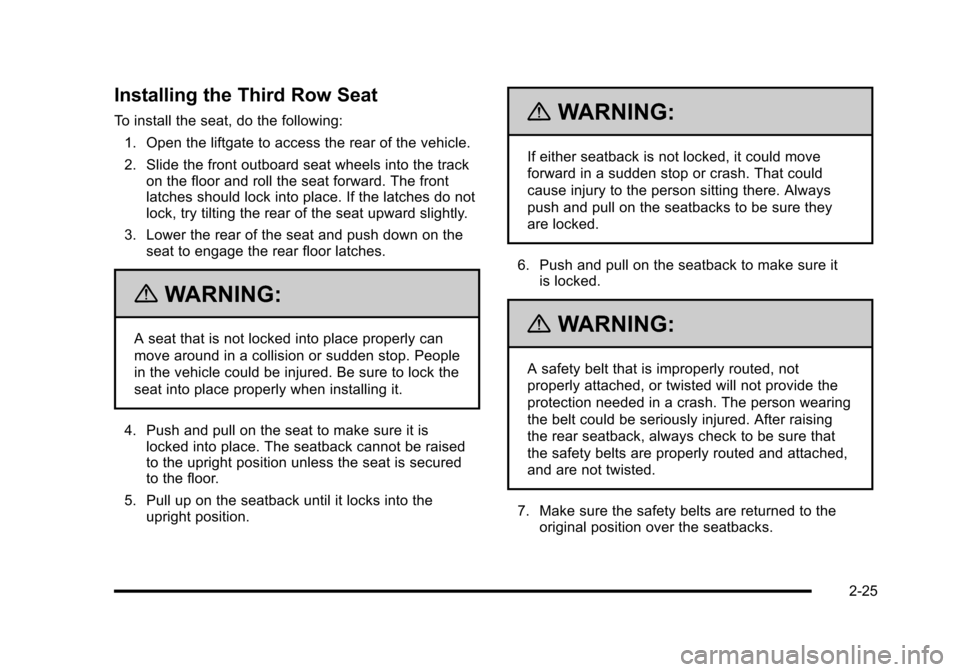
Installing the Third Row Seat
To install the seat, do the following:
1. Open the liftgate to access the rear of the vehicle.
2. Slide the front outboard seat wheels into the trackon the floor and roll the seat forward. The frontlatches should lock into place. If the latches do notlock, try tilting the rear of the seat upward slightly.
3. Lower the rear of the seat and push down on theseat to engage the rear floor latches.
{WARNING:
A seat that is not locked into place properly can
move around in a collision or sudden stop. People
in the vehicle could be injured. Be sure to lock the
seat into place properly when installing it.
4. Push and pull on the seat to make sure it islocked into place. The seatback cannot be raisedto the upright position unless the seat is securedto the floor.
5. Pull up on the seatback until it locks into theupright position.
{WARNING:
If either seatback is not locked, it could move
forward in a sudden stop or crash. That could
cause injury to the person sitting there. Always
push and pull on the seatbacks to be sure they
are locked.
6. Push and pull on the seatback to make sure itis locked.
{WARNING:
A safety belt that is improperly routed, not
properly attached, or twisted will not provide the
protection needed in a crash. The person wearing
the belt could be seriously injured. After raising
the rear seatback, always check to be sure that
the safety belts are properly routed and attached,
and are not twisted.
7. Make sure the safety belts are returned to theoriginal position over the seatbacks.
2-25
Page 71 of 616
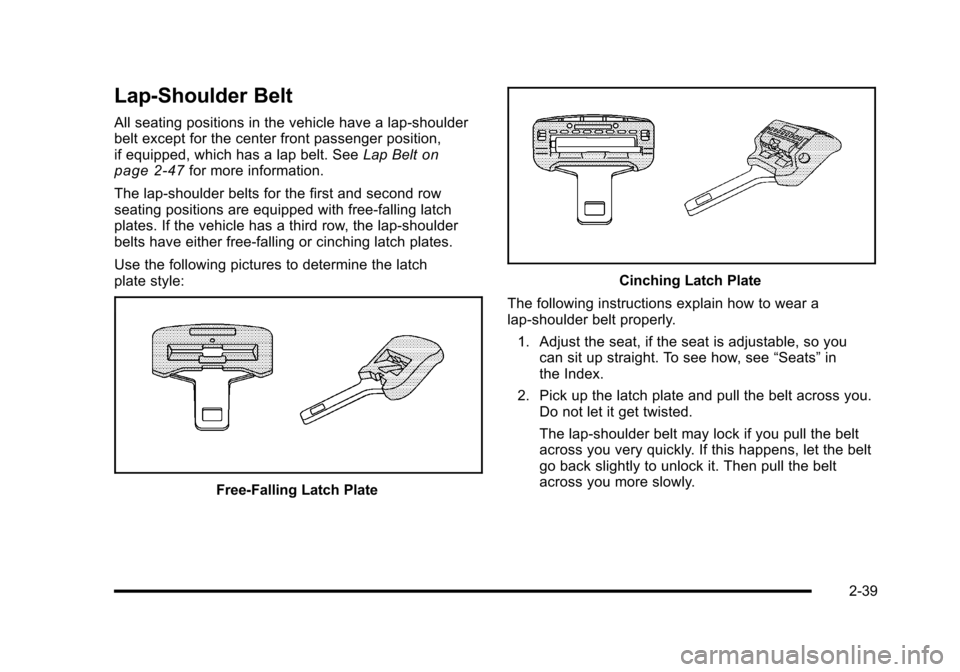
Lap-Shoulder Belt
All seating positions in the vehicle have a lap-shoulderbelt except for the center front passenger position,if equipped, which has a lap belt. SeeLap Beltonpage 2!47for more information.
The lap!shoulder belts for the first and second rowseating positions are equipped with free!falling latchplates. If the vehicle has a third row, the lap!shoulderbelts have either free!falling or cinching latch plates.
Use the following pictures to determine the latchplate style:
Free-Falling Latch Plate
Cinching Latch Plate
The following instructions explain how to wear alap-shoulder belt properly.
1. Adjust the seat, if the seat is adjustable, so youcan sit up straight. To see how, see“Seats”inthe Index.
2. Pick up the latch plate and pull the belt across you.Do not let it get twisted.
The lap-shoulder belt may lock if you pull the beltacross you very quickly. If this happens, let the beltgo back slightly to unlock it. Then pull the beltacross you more slowly.
2-39
Page 106 of 616
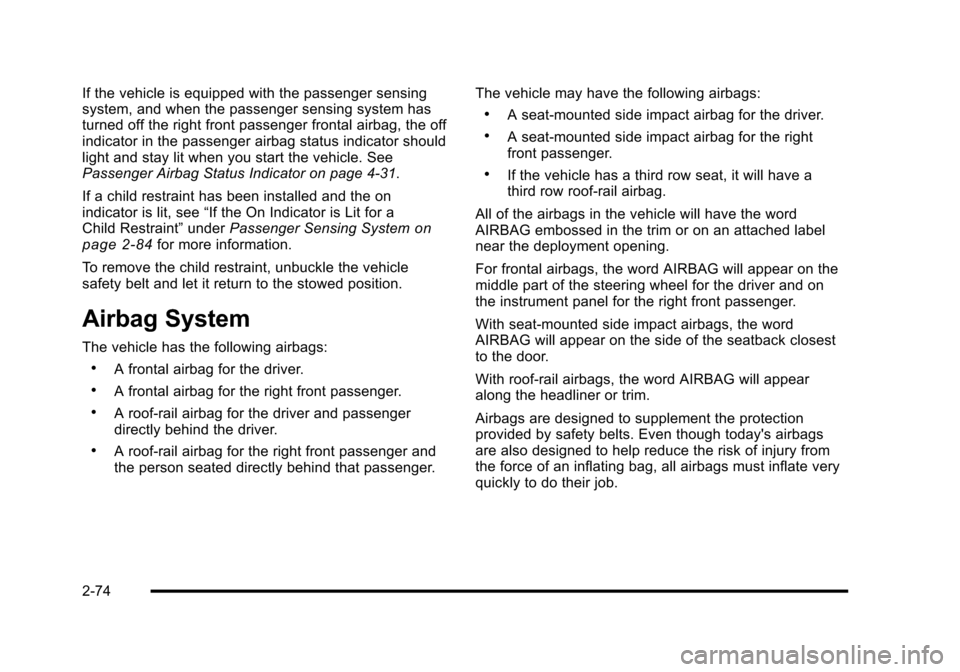
If the vehicle is equipped with the passenger sensingsystem, and when the passenger sensing system hasturned off the right front passenger frontal airbag, the offindicator in the passenger airbag status indicator shouldlight and stay lit when you start the vehicle. SeePassenger Airbag Status Indicator on page 4!31.
If a child restraint has been installed and the onindicator is lit, see“If the On Indicator is Lit for aChild Restraint”underPassenger Sensing Systemonpage 2!84for more information.
To remove the child restraint, unbuckle the vehiclesafety belt and let it return to the stowed position.
Airbag System
The vehicle has the following airbags:
.A frontal airbag for the driver.
.A frontal airbag for the right front passenger.
.A roof-rail airbag for the driver and passengerdirectly behind the driver.
.A roof-rail airbag for the right front passenger andthe person seated directly behind that passenger.
The vehicle may have the following airbags:
.A seat!mounted side impact airbag for the driver.
.A seat!mounted side impact airbag for the rightfront passenger.
.If the vehicle has a third row seat, it will have athird row roof-rail airbag.
All of the airbags in the vehicle will have the wordAIRBAG embossed in the trim or on an attached labelnear the deployment opening.
For frontal airbags, the word AIRBAG will appear on themiddle part of the steering wheel for the driver and onthe instrument panel for the right front passenger.
With seat!mounted side impact airbags, the wordAIRBAG will appear on the side of the seatback closestto the door.
With roof-rail airbags, the word AIRBAG will appearalong the headliner or trim.
Airbags are designed to supplement the protectionprovided by safety belts. Even though today's airbagsare also designed to help reduce the risk of injury fromthe force of an inflating bag, all airbags must inflate veryquickly to do their job.
2-74
Page 108 of 616

{WARNING:
Children who are up against, or very close to, any
airbag when it inflates can be seriously injured or
killed. Airbags plus lap-shoulder belts offer
protection for adults and older children, but not for
young children and infants. Neither the vehicle's
safety belt system nor its airbag system is
designed for them. Young children and infants
need the protection that a child restraint system
can provide. Always secure children properly in
your vehicle. To read how, seeOlder Childrenon
page 2!49orInfants and Young Childrenon
page 2!52.
There is an airbagreadiness light on theinstrument panelcluster, which showsthe airbag symbol.
The system checks the airbag electrical system formalfunctions. The light tells you if there is an electricalproblem. SeeAirbag Readiness Lighton page 4!30formore information.
2-76
Page 117 of 616
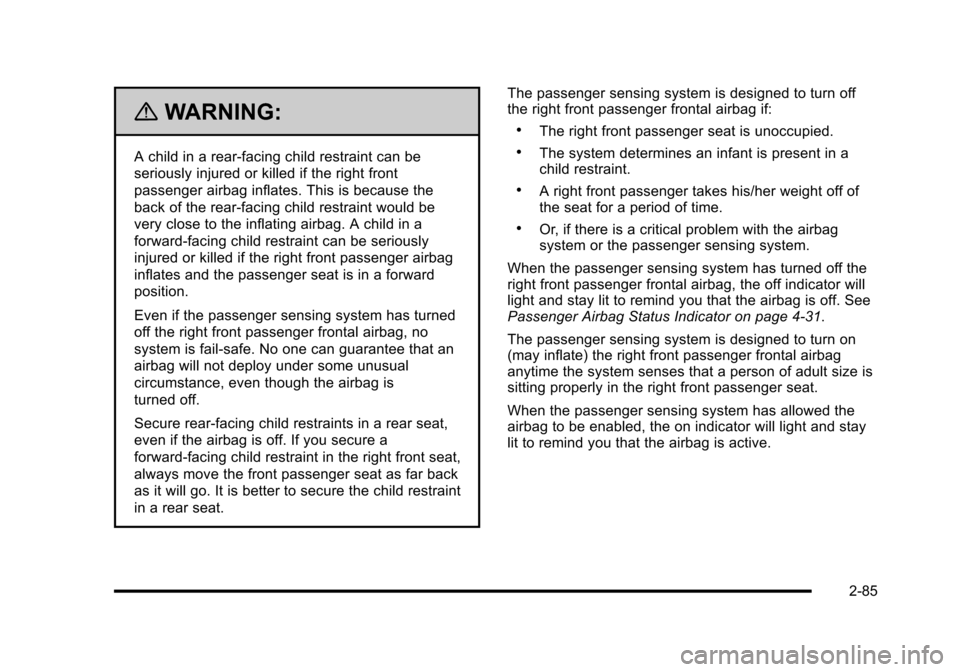
{WARNING:
A child in a rear-facing child restraint can be
seriously injured or killed if the right front
passenger airbag inflates. This is because the
back of the rear-facing child restraint would be
very close to the inflating airbag. A child in a
forward-facing child restraint can be seriously
injured or killed if the right front passenger airbag
inflates and the passenger seat is in a forward
position.
Even if the passenger sensing system has turned
off the right front passenger frontal airbag, no
system is fail-safe. No one can guarantee that an
airbag will not deploy under some unusual
circumstance, even though the airbag is
turned off.
Secure rear-facing child restraints in a rear seat,
even if the airbag is off. If you secure a
forward-facing child restraint in the right front seat,
always move the front passenger seat as far back
as it will go. It is better to secure the child restraint
in a rear seat.
The passenger sensing system is designed to turn offthe right front passenger frontal airbag if:
.The right front passenger seat is unoccupied.
.The system determines an infant is present in achild restraint.
.A right front passenger takes his/her weight off ofthe seat for a period of time.
.Or, if there is a critical problem with the airbagsystem or the passenger sensing system.
When the passenger sensing system has turned off theright front passenger frontal airbag, the off indicator willlight and stay lit to remind you that the airbag is off. SeePassenger Airbag Status Indicator on page 4!31.
The passenger sensing system is designed to turn on(may inflate) the right front passenger frontal airbaganytime the system senses that a person of adult size issitting properly in the right front passenger seat.
When the passenger sensing system has allowed theairbag to be enabled, the on indicator will light and staylit to remind you that the airbag is active.
2-85
Page 118 of 616
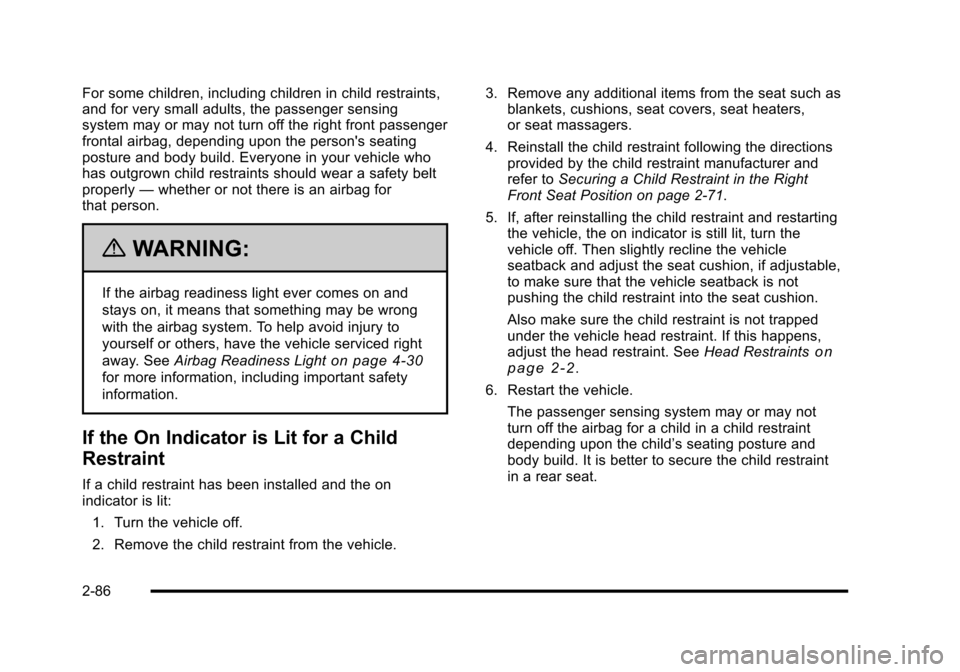
For some children, including children in child restraints,and for very small adults, the passenger sensingsystem may or may not turn off the right front passengerfrontal airbag, depending upon the person's seatingposture and body build. Everyone in your vehicle whohas outgrown child restraints should wear a safety beltproperly—whether or not there is an airbag forthat person.
{WARNING:
If the airbag readiness light ever comes on and
stays on, it means that something may be wrong
with the airbag system. To help avoid injury to
yourself or others, have the vehicle serviced right
away. SeeAirbag Readiness Lighton page 4!30
for more information, including important safety
information.
If the On Indicator is Lit for a Child
Restraint
If a child restraint has been installed and the onindicator is lit:
1. Turn the vehicle off.
2. Remove the child restraint from the vehicle.
3. Remove any additional items from the seat such asblankets, cushions, seat covers, seat heaters,or seat massagers.
4. Reinstall the child restraint following the directionsprovided by the child restraint manufacturer andrefer toSecuring a Child Restraint in the RightFront Seat Position on page 2!71.
5. If, after reinstalling the child restraint and restartingthe vehicle, the on indicator is still lit, turn thevehicle off. Then slightly recline the vehicleseatback and adjust the seat cushion, if adjustable,to make sure that the vehicle seatback is notpushing the child restraint into the seat cushion.
Also make sure the child restraint is not trappedunder the vehicle head restraint. If this happens,adjust the head restraint. SeeHead Restraintsonp a g e 2!2.
6. Restart the vehicle.
The passenger sensing system may or may notturn off the airbag for a child in a child restraintdepending upon the child’s seating posture andbody build. It is better to secure the child restraintin a rear seat.
2-86
Page 123 of 616

Restraint System Check
Checking the Restraint Systems
Safety Belts
Now and then, check that the safety belt reminder light,safety belts, buckles, latch plates, retractors, andanchorages are all working properly.
Look for any other loose or damaged safety belt systemparts that might keep a safety belt system from doing itsjob. See your dealer/retailer to have it repaired. Torn orfrayed safety belts may not protect you in a crash. Theycan rip apart under impact forces. If a belt is torn orfrayed, get a new one right away.
Make sure the safety belt reminder light is working.SeeSafety Belt Reminderson page 4!29for moreinformation.
Keep safety belts clean and dry. SeeCare of SafetyBeltson page 7!102.
Airbags
The airbag system does not need regularly scheduledmaintenance or replacement. Make sure the airbagreadiness light is working. SeeAirbag Readiness Lighton page 4!30for more information.
Notice:If an airbag covering is damaged,opened, or broken, the airbag may not workproperly. Do not open or break the airbag coverings.If there are any opened or broken airbag covers,have the airbag covering and/or airbag modulereplaced. For the location of the airbag modules,seeWhat Makes an Airbag Inflate?on page 2!81.See your dealer/retailer for service.
2-91
Page 124 of 616

Replacing Restraint System Parts
After a Crash
{WARNING:
A crash can damage the restraint systems in your
vehicle. A damaged restraint system may not
properly protect the person using it, resulting in
serious injury or even death in a crash. To help
make sure your restraint systems are working
properly after a crash, have them inspected and
any necessary replacements made as soon as
possible.
If the vehicle has been in a crash, do you need newsafety belts or LATCH system (if equipped) parts?
After a very minor crash, nothing may be necessary.But the safety belt assemblies that were used duringany crash may have been stressed or damaged. Seeyour dealer/retailer to have the safety belt assembliesinspected or replaced.
If the vehicle has the LATCH system and it wasbeing used during a crash, you may need new LATCHsystem parts.
New parts and repairs may be necessary even if thesafety belt or LATCH system (if equipped), was notbeing used at the time of the crash.
If an airbag inflates, you will need to replace airbagsystem parts. See the part on the airbag system earlierin this section.
Have the safety belt pretensioners checked if thevehicle has been in a crash, if the airbag readiness lightstays on after the vehicle is started, or while you aredriving. SeeAirbag Readiness Lighton page 4!30.
2-92